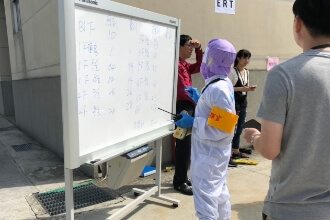Environmental Sustainability
Climate and Energy
Climate change and energy transition are critical challenges that require global collaboration. PTI has established an Environment, Health, and Safety Committee composed of top-managers and cross-departmental representatives, to take charge of developing, coordinating, and implementing initiatives related to environmental sustainability and climate change. Moreover, to enhance resource efficiency, we have formed a cross-functional Energy Conservation Task Force with members from facilities, equipment, production, and environmental safety units. This task force sets performance indicators and proposes practical energy-saving measures. Through continuous validation of these initiatives, we strive to effectively and sustainably reduce energy consumption and improve operational efficiency.
Energy Management
PTI’s energy usage across all operational sites includes electricity, natural gas, and diesel, with no heat supply from other energy sources. These are sourced from government-owned power plants, public natural gas utilities, and fueling stations, with electricity being the predominant source. To monitor energy usage and enhance efficiency, we have implemented energy management and obtained ISO 50001 energy management systems certification for 8 plants. New facilities are designed with green building concepts to reduce energy and resource consumption. Environmentally friendly refrigerants with low global warming potential are utilized, while high-efficiency motors (IE3 or higher) are selected for rotating equipment. Site-wide energy-saving measures, such as cooling system upgrades, dryer replacements, water recycling, optimized machine settings, computer renewal, improved lighting, and after-hours shutdown protocols, have been adopted to reduce energy losses.
■ Purchased 20,894 renewable energy certificates (T-RECs) in 2024. For details on renewable energy usage, please refer to the “Clean Tech” section.■ Quantitative data on energy saving or carbon reduction
In 2024, an estimated 14,182,415 kWh of electricity was saved, reducing approximately 7,006.11 metric tons of CO₂e emissions. This achievement met the energy-saving target of 1%.
■ Energy Consumption in 2024- Electricity consumption totaled 712,134,409 kWh (2,563,683.87 GJ), with an electricity intensity of 15.05 kWh/ thousand (NTD). Compared to 2023, electricity usage increased by 38,981,259 kWh (140,332.53 GJ).
- Natural gas consumption totaled 427,559 m3 (16,554.71 GJ), reflecting a decrease of 67,134 m3 (259.92 GJ) compared to 2023.
- Diesel consumption totaled 12,120.01 L (457.61 GJ), indicating a decrease of 1,290.06 L (48.71 GJ) compared to 2023.
Note 2:1 m3 = 9250 kcal/ m3 x 4,185.8518 GJ
Note 3:1L = 0.82 density x 11,000 kcal/kg x 4,185.8518 GJ
Note 4:Electricity intensity (kWh/ thousand dollars) = electricity consumption (kWh)/ individual revenue (thousand (NTD)).
Note 5:Energy intensity (GJ/thousand (NTD)) = consumption of electricity + natural gas + diesel (GJ)/ individual revenue (thousand (NTD)).
Note 6:The energy saving calculation method is calculated by measurements against a checklist, inference based on existing meters, or inference with the rated capacity of equipment. Suitable inference criteria are selected to reflect the actual circumstances.
Note 7:Energy saving goal: annual electricity conservation rate of 1%, based on the actual amount of electricity used in 2023. 673,153,150 kWh*1% = 6,731,532 kWh
PTI Energy Consumption and Energy Intensity
GHG Inventory
PTI follows ISO 14064-1:2018, as well as other domestic and international guidelines to establish a greenhouse gas (GHG) inventory management process. Climate risk assessments are conducted in alignment with the risks and opportunities defined by the TCFD, with mitigation strategies developed to minimize potential impacts.
The 2024 PTI GHG emissions data consists of actual inventory checks performed at respective plants. The data encompasses operation-related direct GHG emission sources (Category 1), energy indirect GHG emission sources (Category 2), and other indirect GHG emission sources (Category 3 to 6). Category 1 emissions totaled 7,455.97 MTCO2e, and Category 2 emissions reached 339,416.97 MTCO2e, together amounting to 346,872.94 MTCO2e. Of this total, Category 1 emissions accounted for approximately 2.15%, while Category 2 made up about 97.85%, primarily attributable to purchased electricity. Accordingly, PTI’s GHG reduction strategy emphasizes electricity consumption management and energy-saving measures, with a 1% annual energy-saving target to effectively reduce emissions. (Click here for the third-party Greenhouse Gas Emissions Verification Opinion Statement.)
PTI 2024 Greenhouse Gas Inventory Summary
- Total Emissions
- MTCO2e
- 7,455.97
- 339,416.97
- 346,872.94
- Emissions Intensity
- MTCO2e / NT$ million
- 0.16
- 7.17
- 7.33
Note 2:The emission factor for purchased electricity in 2023 is 0.494 kg CO₂e/kWh, as announced by the Taiwan Ministry of Economic Affairs Energy Administration.
Note 3:The emission factors of CO2, CH4, and N2O from stationary and mobile combustions are based on the greenhouse gas emission factors announced by the Ministry of Environment, Taiwan.
Note 4:The operational control approach was adopted to compile total GHG emissions.
Note 5:Emissions intensity = total emissions (MTCO2e) / individual revenue (NT$ million)
Overview of Other Indirect GHG Emissions (Category 3~6)
GHG Reduction for 2050 Net-Zero
In response to the global climate crisis and carbon reduction initiatives, PTI has set short-, medium-, and long-term greenhouse gas reduction targets based on the 2020 baseline year. These targets include a 5% reduction by 2025, 15% by 2030, and achieving net-zero emissions by 2050.
To fulfill this vision, we have actively promoted multiple strategies such as energy conservation, renewable energy deployment, and low-carbon product innovation. In 2024, a total of 159 energy-saving and carbon-reduction measures were implemented across factory operations and production facilities to reduce energy consumption and GHG emissions.
PTI continues to set annual energy-saving goals and improve electricity efficiency, supported by internal programs and incentive mechanisms that encourage active participation from both management and employees. All initiatives are carried out under the principles of measurability, reportability, and verifiability, and are aligned with the United Nations Sustainable Development Goal (SDG) 13: Climate Action, as we move steadily toward a low-carbon and sustainable future.
PTI Energy Conservation and Carbon Reduction Measures
Climate Change Response (CDP and TCFD Disclosure)
In support of the Paris Agreement’s goal to limit global warming to within 2°C and striving to achieve the 1.5°C target, PTI has participated in the climate change project initiated by CDP since 2015, disclosing responses to both the Climate Change and Water Security questionnaires. In 2024, the Company received a B Rating in the Management Band from Climate Change and Water Security questionnaires of CDP.
Since officially becoming a supporter of the Task Force on Climate-related Financial Disclosures (TCFD) in July 2020, PTI has proactively advanced both climate adaptation and mitigation efforts. Each year, we follow the TCFD framework to identify and analyze climate-related risks and opportunities, including transition and physical risks, in order to formulate environmental management policies and implement concrete measures.
To address the impacts of climate change, reduce environmental risks, and ensure sustainable operations, PTI works in close collaboration with employees, customers, and suppliers to accelerate the low-carbon transition. Together, we are committed to achieving net-zero carbon emissions by 2050 and creating a sustainable future. (For more details, please refer to the 2024 TCFD Report.)
EHS Awareness Promotion
PTI recognizes that cultivating environmental protection awareness requires a deeply rooted and long-term approach. To continually enhance employees’ understanding of safety, environmental protection, and health promotion, we organize a series of educational campaigns starting from the theme of environmental sustainability. These efforts include multimedia exhibits, on-site demonstrations, and health-focused content aimed at deepening the concept of sustainability and reinforcing our corporate responsibility.



